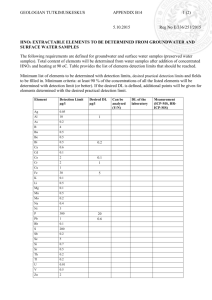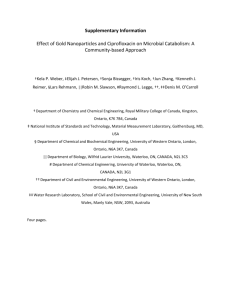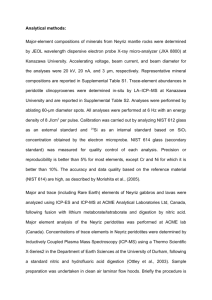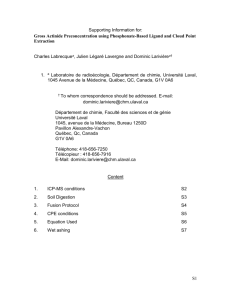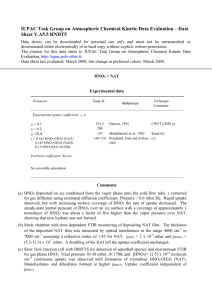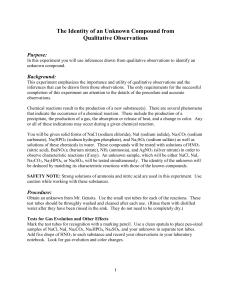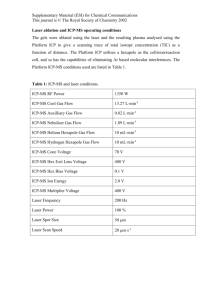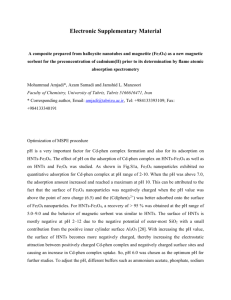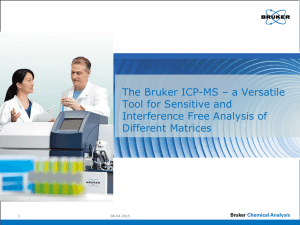BKamber_PresentationAugust2010
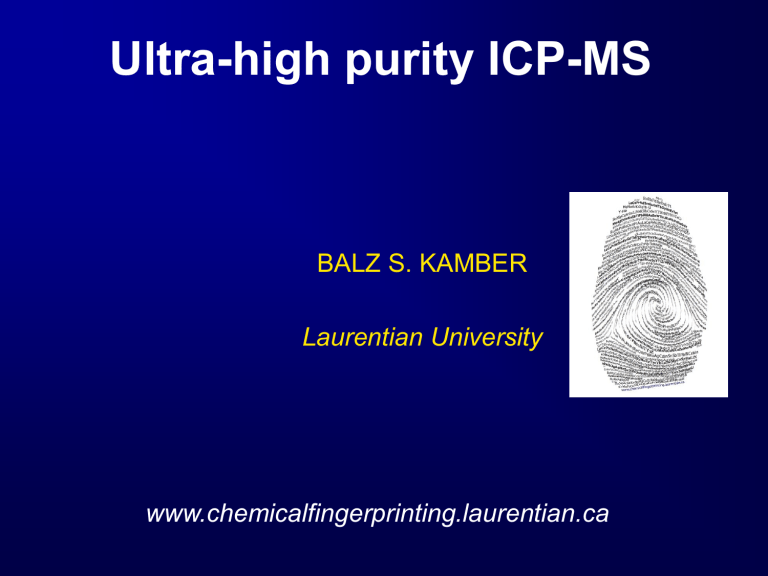
Ultra-high purity ICP-MS
BALZ S. KAMBER
Laurentian University www.chemicalfingerprinting.laurentian.ca
Drivers behind geo- and cosmochemical analysis
Desire to analyze subnanogram quantities of implanted solar wind, returned cometary material, dust in Antarctic ice, etc.
Analytic equipment: SIMS
Secondary ion mass spectrometer
Pros: Ideal for in situ analysis, quasi nondestructive, high spatial resolution, high mass resolution, for some elements ppt detection limits
Cons: sample in ultra-high vacuum, requires perfect surface for ppt analysis, matrix effects, slow, and $
Analytic equipment: ICP-MS
Inductively coupled plasma mass spectrometer
Pros: ppq detection limits, can work in situ or analyze digests, samples at atmospheric P, matrix insensitive, fast, relatively inexpensive
Cons: destructive, requires more material than
SIMS, prone to blank contamination during sample preparation, may require elemental preconcentration
Solution ICP-MS
Instrumental limits: ICP-MS
Sensitivity:
Detection limit:
450,000 cps ppb -1
1 cps
Consumed mass: 2 grams
Absolute mass of detected material: 4-5 femtograms (10 -15 g)
Dilution factor (solution/solid ratio): 1,000
Hence in 2 g of solution, only 2 mg of solid translates to minimum detectable concentration of 4-5 nanograms g -1 (ppt)
Current standard practice for easy metal (e.g. Cu)
•Up to 0.25 g of sample dissolved
•Metal or alloy dissolves slowly in 10% HNO
3
, in pre-cleaned 0.25 L PP bottle
•Take 2 g aliquot, add internal standard for drift correction and run on ICP-MS
•Analysis includes a semi-quantitative mass scan
Simple metal results
Note outlier
Current standard practice for pesky metal (e.g. certain bronzes)
•Up to 0.25 g of sample dissolved
•Alloy attacked by aqua regia in ultra-clean
Teflon vials at 160degC, converted with HNO3 and taken up in 10g of 20% HNO
3
•Take 0.24 g aliquot, add internal standard for drift correction, dilute to 6 g with H
2
O and run on ICP-MS
•Abandoned U & Th pre-concentration (blank)
• Analysis includes a semi-quantitative scan
Current standard practice for Sibased, HFSE-doped chips
•Very small chips (a few mg) rinsed in ultraclean 5% HNO
3
•Attacked in ultra-clean Teflon vials with 0.25 mL HNO
3
160degC conc. and 0.5 mL HF conc.
•Conversion with HNO
3 to boil off Si as SiF
4 and taken up in a few g of 5% HNO
3 with internal standards
•Run on ICP-MS, including a semi-quantitative scan
Chip results 10 mg samples
Chip results sub 10 mg samples
Chip results semi-quantitative mass scan
Chip results semi-quantitative mass scan
Ideas for new procedures
•Wipes
•Metals and chips: improve detection limits by chromatographic matrix exclusion
•Pre-concentrated U and Th: improve blanks and counting statistics by laser ablation
•Addition of 234 U and 229 Th spikes
Wipes
•Combust in quartz crucibles in SNO above-ground facility
•Take-up ash into 6mL Teflon vessel
•Digest ash in 0.2mL HF
•Convert with HNO
3 and analyze in 2 mL of 5% HNO
3 with internal standards
•Common procedure for environmental samples (peat)
Matrix removal
•Previous efforts at pre-concentrating Th and U focused on ion chromatography that specifically retains U and Th
•This is the method preferred by Patricia
Grinberg
•For small samples, this method reaches a blank limit as the U-TEVA resin itself appears to contain a blank
•Alternative is to remove matrix (all 1+,
2+ and 3+ charged cations) on cation exchange resin
Analyze pre-concentrated U and
Th as a UV-laser induced aerosol
•Dry down U and Th pre-concentrate into inert clean Teflon vial
•Vaporize residue (and Teflon) with a few pulses of an Excimer laser
•Transport aerosol into ICP-torch in
99.9995% He clean stream
UV- laser idea
Analyze pre-concentrated U and
Th as a UV-laser induced aerosol
•Higher ionization efficiency, larger signal, lower blank
•But need for yield monitor: isotope dilution
•Addition of known amount of isotopically enriched 234 U and 229 Th
Outlook
•Simple metals with low contamination risk and wipes can be handled with existing protocols in lab
•Dangerous metals (Pb, certain bronzes) and HFSE-doped chips need to be digested in a nongeochemical/cosmochemical lab
•We can train personnel to learn these techniques
•Publication quality experiments should be performed by a Postdoc
